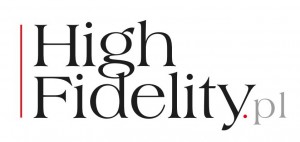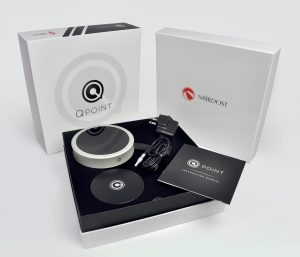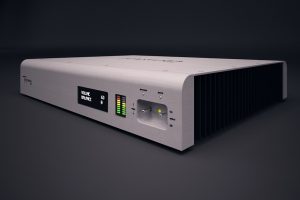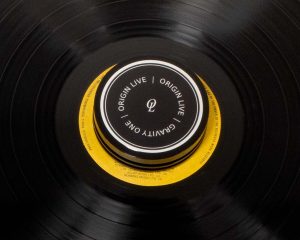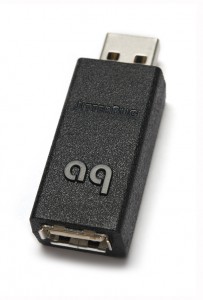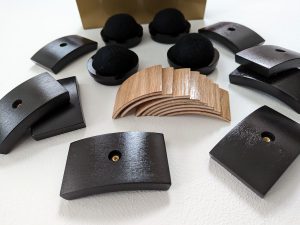The bad is a magical space
Whispers screams and laughter
There is room for happiness
There is room for sin
It's an island of pleasure
A sea of loneliness
It's a place of birth
And a door to nothingness
Olga Jackowska, Łóżko in: Maanam, Łóżko, Kamiling Co. | Pomaton EMI 852718, CD (1996)
Let's replace the word "bad" with "audio" in this text, and we shall see a surprisingly accurate picture of audio. On one hand it is a social, collective affair, on the other it is particularly private, individual. It's our place of dazzles and refraction, refreshing discoveries and hoaxes. And at the end we are all alone in it. It is worth to rely on oneself, on one's own experience, but one should not forget one's trusted friends and acquaintances, as well as the producers who did not disappoint before and whom one trusts. I would particularly like to focus on the latter—it is really worth to find yourself a trustworthy brand, because it is not true that all of them want to deceive us.
Whom to believe, and who should not be trusted one can learn by listening and using the products of the brand and whenever possible compare them with products of other manufacturers. Valuable information can also be found in expert magazines and in users' testimonies. As far as one finds them trustworthy. Because our entire industry is largely built on trust we put on someone else. It is verified by listening, but ultimately they are only one of several elements that affect our decisions, i.e. how we spend our money. Even if we believe we make absolutely independent decisions.
We are tried every time a company offers us a new product or a new version of one that we already know. It has to balance its whole activity between the need for updating the lineup on regular bases (a commercial requirement) and the need to make changes, upgrades resulting from new developments, completely new or replacing older models/versions components (a technical requirement). The bigger the brand, the higher the priority of the commercial requirements. And the other way around—the smaller firm, the more important the technical aspect becomes.

RAS-14 Triple-C
The Japanese Acoustic Revive company, led by its founder, Mr. Ken Ishiguro belongs to the latter. New products are introduced rarely and almost unwillingly. It does happen sometime, however, that the lineup must undergo a revolution as it does when one of the key components disappears from production. In the case of the Acoustic Revive and a large group of other Japanese producers, such an earthquake was caused by Furukawa when they stopped the production of PCOCC cables. I wrote about it several times, for more information please go HERE and HERE.
Acoustic Revive decides to use the PC-Triple C copper instead. It is obtained by a process similar to forging in which the wire is struck several times. Strikes have the right angle and direction that were experimentally established. As a result of this treatment, material reduces its volume by 70%. This is a clear reference to the Japanese sword-smith tradition, and that is why, in Acoustic Revive commercials, we can find the image of a katana blade. This type of cable has been used in all AR cables, also in the latest additions to the range, RSA-14 Triple-C and RPC-1 Passive EMI / RFI filters.
The Passive EMI / RFI filters have been known for many years, used mostly by industry - mainly IT, medical and defense. For several years, they have also been used by audio companies such as, for example, Nordost (QRT Qv2), Entreq, Verictum (X Bulk), the reviewed Acoustic Revive, and also by Furutech (Flux-50 NFC; Polish). The most common are filters that are linked to a power cable (they are sometimes called "serial"), but recently more new products arrived on the market that are plugged independently to a free socket (they are called "parallel"). The way they work varies from model to model, from company to company, but generally the goal is to minimize RFI noise, and often also to minimize the vibration of the conductor.
The 5990 PLN RSA-14 Triple-C belongs to the former group of products. It's a kind of "adapter", with an IEC connector on one side and an IEC socket on the other. These are connected with a 20 cm Power Reference Triple-C power cable. Previously, this was the Power Reference PCOCC copper cable. The socket is screwed to something like a rattle—it's a short tube made of carbon fiber braid, closed on both sides with wooden plugs. A mixture of crystals and RFI / EMI reacting elements were placed inside. This is a proprietary Acoustic Revive solution, that has been used in their products for years. For some time now, similar solutions have also been utilized by other manufacturers.
From the old version this one also differs with usage of other plug and socket. The FI-50 NCF (R) connector and the FI-06 NCF (R) socket are sourced from Furutech. As I have already mentioned several times, these are ones of the best power plugs available presently, chosen by many top manufacturers. Enough said that for their new top-of-the-line Triple Crown power cables Siltech also decided to use these connectors. Let me remind you that Furutech has used the Nano Crystal² Formula (NCF), a vibration reduction technique that utilizes crystalline material with "active" properties. First, it generates negative ions, eliminating the static charges from the material. Second, it turns kinetic energy into infrared radiation. Hence, it's a piezoelectric material that converts the vibration into heat.
Metal contact elements are made of non-magnetic, rhodium-plated materials (OCC) Alpha processed (demagnetization and cryogenic processing). It features a multi-layer body: it combines non-magnetic stainless steel and silver-plated carbon fiber and a layer of acetate co-polymer.
The previous version of the filter used Oyaide IEC connector with rhodium-plated contacts, custom-made for AR. The FI-10 IEC socket was sourced from Furutech. New plugs and a new cable. The only part taken from the old RSA-14 is a filter element, although it features now a slightly different mix inside.

RPC-1
The RPC-1 is one of the most expensive passive filters I know (11,900 PLN). It is a completely new product in the Acoustic Revive range. This is a filter plugged into a free socket in a power strip that also other power chords are connected to. Like all other AR products, also this one is based on scientific research - in this case of Mr. Jun Shibata. Let me remind you that Mr. Jun Shibata is a man who developed a prototype of a IR computer mouse. The research concerned high frequency noise in AC power lines that caused interference in the prototype's work.
Based on his observations Shibata-san built a filter that eliminated this interference. It consisted of a set of capacitors, resistors and coils. His own contribution was a selection of coils assembled in parallel to the cold and hot supply lines. This solution attracted Mr. Fukushima's attention, the head of HWT, working for the industrial sector. He bought the rights to this solution and based on them he developed an industrial filter eliminating RFI noise.
Our friend, Mr. Ken Ishiguro, decided to use this work to clean the power lines that the audio devices use. So he established a partnership with HWT and, based on their industrial model, developed a more powerful system, tuned for use in audio systems. The result was the Acoustic Revive RPC-1 Power Supply Conditioner. Its appearance refers to SPEC loudspeaker filters. This is quite a large wooden box with 20 cm Power Reference Triple-C power cable, terminated with FI-E11 N1 (G) connector. The box can not be opened so the components used and their layout remain a corporate secret.
REVIEW METHODOLOGY
My methodology of a test of this type of filter checked out several times in the past. The impact the RAS-14 Triple-C filter has on the sound can be tested in a simple A / B / A comparison with known A and B, where 'A' is a device powered without filter and 'B' wit it. It is important, however, what cables are used for such test - in my experience these should be made of the same material as the cable that is part of the filter.
For this test I used the Acoustic Revive Power Reference Triple-C and Acrolink Mexcel 7N-PC9500. The former is made of Triple-C solid-core copper wires and features Furutech Shuko I-E50 NCF (R) and FI-50 NCF (R) plugs, the same as the AR cable. Acrolink cables are made of the D.U.C.C. "Stressfree" square cross section copper made by Mitsubishi featuring custom-made plugs with rhodium-plated contacts and carbon fiber body.
The RPC-1 filter is more difficult to evaluate. These type of passive component must be plugged into the mains power for several days before they can be properly assessed. In his case, I performed an A / B comparison, where 'A' was a system working with the filter and 'B' was working without it. For several days, the filter was permanently plugged in, and during the test, after a dozen or so tracks it was removed (unplugged). This procedure was repeated over several days. The filter was placed on the Acoustic Revive TB-38H anti-vibration platform and was plugged into the Acoustic Revive RTP-4eu Ultimate power strip.
SOUND
- Claudio Monteverdi, Ottavo Libro Dei Madrigali, perf. Concerto Italiano, Rinaldo Alessandrini, Opus111 OPS 30-187, CD (1997)
- Chet Baker, It could happen to you, Riverside/ZYX Music OJC20 303-2, "Original Jazz Classics", Super Bit Mapping CD (1958/1987)
- Enya, The Memory of Trees, Warner Music UK/Warner Music [Japan] WPCR-13300, SHM-CD (2009)
- Novika, Tricks of Life, Kayax 013 CD (2006)
- OMD, English Electric, 100% Records/Sony Music Japan SICP-3810, CD (2013); review HERE
- Polish Jazz Quartet, Polish Jazz Quartet, Polskie Nagrania "Muza"/Warner Music Poland, "Polish Jazz | vol. 3", Master CD-R (1965/2016); review of the CD version HERE
The influence of this type of products, passive filters, whether used for power line or used to block EMI / RFI radiation entering system components from outside (see Verictum X Block) - can only be appreciated when everything else in our system has been "straightened out". Plugging the RPC-1 filter "into" power line, also "upgrading" our power cable with RAS-14 Triple-C filter should be one of the last elements of any audio system "tuning". They can not be treated as a solution to some "sickness" of the system, but rather as a final touch to an already properly setup one.
This does not mean, however, that their influence on sound is insignificant. Both these products clearly change it. However, their advantages become more obvious when a "ground" for their work has already been set up, when they do not have to improve some particular aspect of the sound that we couldn't get better in any other way. In a word: they should be supporting those system features that were already good before, minimizing the problem of having our devices powered from a "contaminated" power supply.
RAS-14 Triple-C
Under such assumptions, we will hear how the RAS-14 Triple-C captivates us with the energy of recordings as well as improves clarity of the presentation. This could be achieved by, for example, emphasizing the sound's attack phase, a slight preference of the leading edge at the expense of sustain phase, and it would also be OK. However, this would be an ad hoc action that is acceptable - when cleverly applied—on an entry to mid price level systems. The Acoustic Revive filter is meant for high end users who shall get the same results via higher resolution and lower "background noise".
The point is, that every recording, whether it was the refined classics of Monteverdi's Ottavo Libro Dei Madrigali performed by Concerto Italiano or the compressed but very well-produced OMD's English Electric sound. First of all, the sound was richer and the bodies of instruments were more three-dimensional. With RAS filter sound was more tangible, i.e. the volume was bigger and clarity higher. Vocals had a clearer body, although they were not "cut out", nor even pushed out of the background. It was about a better definition of both instruments and vocals as well as the whole presentation.
The improvement the RAS introduces to the sound is unequivocal and I can not imagine a system in which it would not be appreciated. How big change in sound came from simply replacing the plugs and the 20 cm power cable I learned comparing the new Triple-C RAS to the previous one with Oyaide plugs and the PCCOC copper wire cable with solid-core oval cross section wires.
The older version worked perfectly making sound more natural. Its influence one could compare to the replacing granite base under loudspeakers with a high-end wood one. I'm sure many of you have tried such that—with time I increasingly appreciate the Japanese vision of sound, i.e. using natural wood wherever possible in audio system. The older RAS sounds warm, gentle, in a more "round" way. The new, however, is better, because it is clearer, more dynamic, and it ensures a better differentiation of a sound material. The new version is clearly more effective, although the older one has its advantages. The older one charms listener, and the newer one improves the performance.
RPC-1
After plugging the new RAS-14 Triple-C filters into all components in the system, I could finally listen to what the RPC-1 added to the mix. Since I had previously dealt with this type of filters, I knew that in their case the advantages and disadvantages would be revealed over a longer time. Quick comparisons could show me this and that, but on a smaller scale and only some aspects of supposed improvement. Despite this, the changes introduced by RPC are readable and one starts to appreciate them quickly. The sound with the filter seems cleaner and more distinct than without it. While RAS smooths the attack, slightly improving the richness, RPC seems more explicit, has a more open midrange. It does not sharpen nor brighten anything, but the sound seems more - I repeat - open.
Depending on the system, this effect will be either an advantage, a step up or a step to the side. In good systems we will get more information and, as a result, a more convincing performance. Listening to vocals from the Ottavo Libro Dei Madrigali, plugging the RPC to the system, I felt as if the vocalists came to me a bit closer. It was not that I moved closer to them as the acoustics did not change, everything was the same, but the voices were clearer and slightly moved in my direction. The change was kind of small but with really sophisticated systems it should be perceived as significant one. As it turned out, it was about more details and subtleties delivered in the upper midrange, which translated into a much better differentiation of recordings. And that meant that I was in fact closer to the original than before.
Summary
Both filters had a significant influence on my system's performance. The introduction of the RAS-14 Triple-C filter could be compared to switching from a "normal" Japanese release of a CD to its SHM-CD or HQCD version. This is a big change, a clearly positive one. The new version of the filter is different from the older one and the place for the latter, in my opinion, is in systems that need coloring, making sound richer and more three-dimensional. Holding on to this comparison, let's say that a non-filtered power cable sounds like a good European release, and with the filter like a Japanese one. The new version adds on top of that a much higher clarity and more energy.
The RPC-1 performs differently. At first its impact seems smaller, one realizes and appreciates its importance more in a long run. Then it turns out that it wasn't IT before. It is worth noting that this filter is not as universal as RAS. But it also fits perfectly into what the latter does, because it also cleans up the "foreground" of the noise we previously received with music and we were not even able to point out. Simply without it the sound is less direct, less "here and now".
Of these two, RAS-14 Triple-C brings immediate improvement. If you can, apply it to all devices in your system, because the effect is cumulative. And ultimately add also RPC-1 and you will find yourself in heaven.
AC Stabilizer | Power Supply Conditioner RAS-14 Triple-C | RPC-1
Prices (in Poland):
- RAS-14 Triple-C – 5990 PLN
- RPC-1 – 11 900 PLN
Acoustic Revive
SEKIGUCHI MACHINE CO., LTD.
Yoshi Hontai | MuSon Project, Inc.
MADE IN JAPAN
Provided for test by: MUSON PROJECT, Inc
Text: Wojciech Pacuła | Images: Wojciech Pacuła
Translation: Marek Dyba









